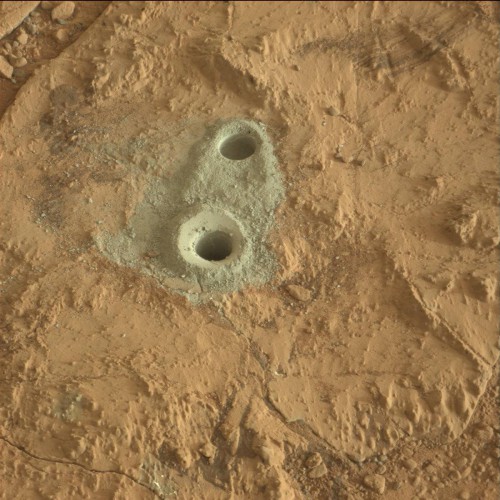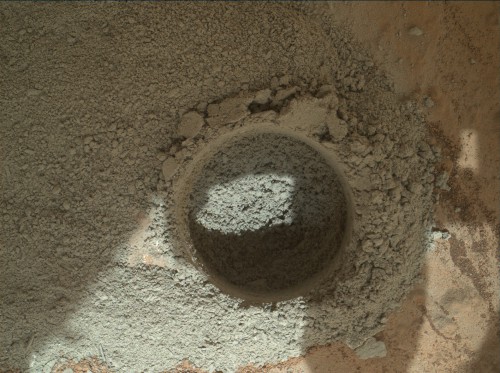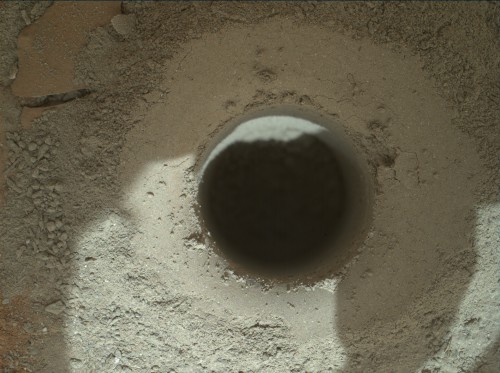
Photo Credit: NASA / JPl-Caltech / MSSS
The Curiosity rover has successfully used its drill to obtain a sample from inside Martian bedrock! This is the first time ever that such a drilling has been done on Mars, and it has provided the first sample from sedimentary bedrock, preserved and untouched for millions or billions of years, which will soon be analyzed by the most advanced laboratory to ever be sent to another planet.
The rock that the MSL rover drilled into has been dubbed “John Klein,” in honor of MSL’s deputy project manager who passed away in 2011.
A few days ago, Curiosity had drilled its first hole as a “mini-drill test,” but did not collect any sample material that time. This first test, using the rotating drill bit, produced a hole about 0.63 inches (1.6 centimeters) in diameter and 0.8 inches (2 centimeters) deep. The powdery drill cuttings were studied first to make sure it was safe to proceed with the second “full” test (without damage to the drill bit from the first test), which was done at maximum depth (a couple of inches), and a sample was collected for on-board laboratory analysis.
This second hole is deeper than the first—about 2.5 inches (6.4 centimeters)—but about the same width as the first one. The powdered rock which has spilled out from the holes is distinctly grey, while the dust coating on the surface of the bedrock is the typical reddish-brown that Mars is famous for.

As John Grunsfeld, NASA associate administrator for the NASA’s Science Mission Directorate, explains, “The most advanced planetary robot ever designed is now a fully operating analytical laboratory on Mars. This is the biggest milestone accomplishment for the Curiosity team since the sky-crane landing last August—another proud day for America.”
Before the sample can be analyzed, some of the material will be used to “scrub” the internal areas of the drill bit assembly, to make sure it is clean and free of any contaminants which may still be there from when Curiosity was still on Earth. The rest of the sample will then be deposited into the Chemistry and Mineralogy (CheMin) and Sample Analysis at Mars (SAM) instruments.

These are only the first of many such drillings planned as Curiosity continues to make its way closer to Mount Sharp, that huge sedimentary mound in the middle of Gale crater. Just like in the Grand Canyon, the layers here record various episodes of geological activity earlier in Mars’ history.
But even before then, it will be interesting to see these first analysis results; Curiosity has already found evidence that this area inside Gale crater was once soaking wet with water and even had a stream running through it a very long time ago. The rover’s main objective is to see whether the environment here could have supported life, at least microbial, and these first detailed studies of the ancient bedrock should be another big step toward answering that question.




Anxiously awaiting the findings…spectacular work!
This is an outstanding picture…Does anyone know is that the current real level of sun light on the surface or brightened in photo processing?
This certainly makes one grateful that of the thousands of generations of humans who have walked this planet, we are alive to witness this product of NASA engineering genius. Curiosity will not generate a profit (other than T-shirts, Match Box miniatures, and bumper-stickers), but what value would you place on what NASA/JPL has achieved with this mission (which is far from complete)?